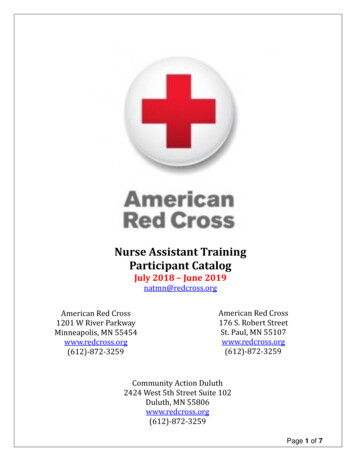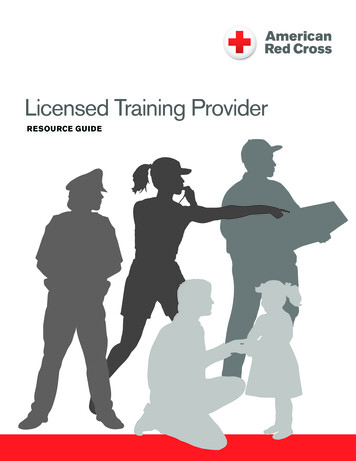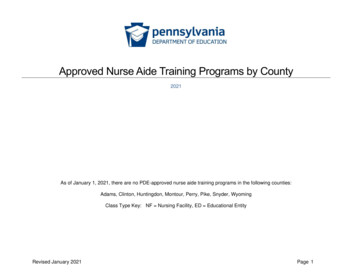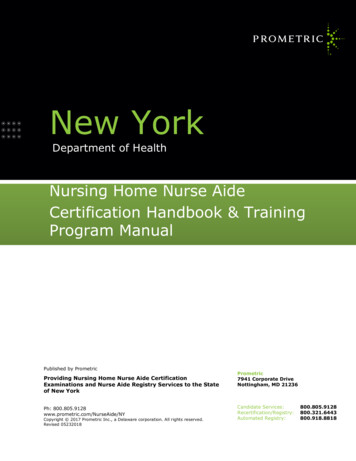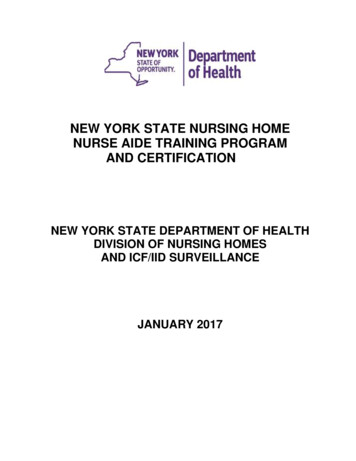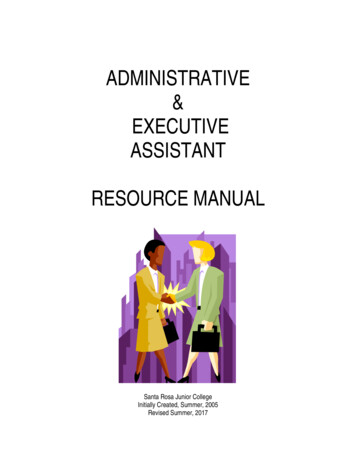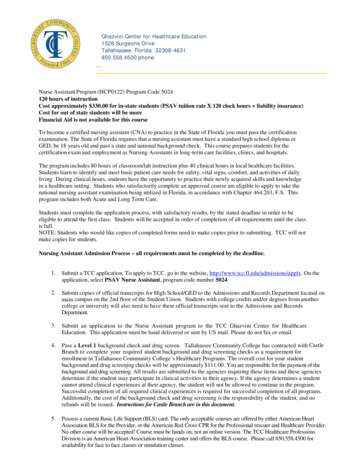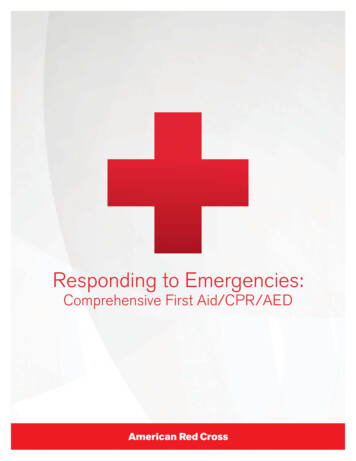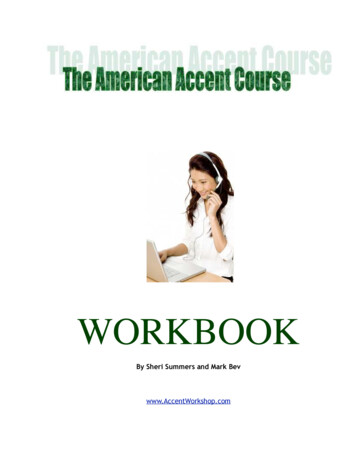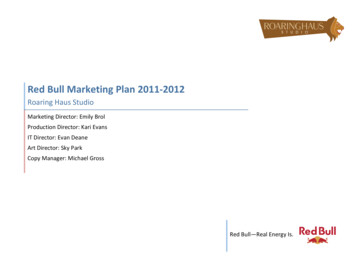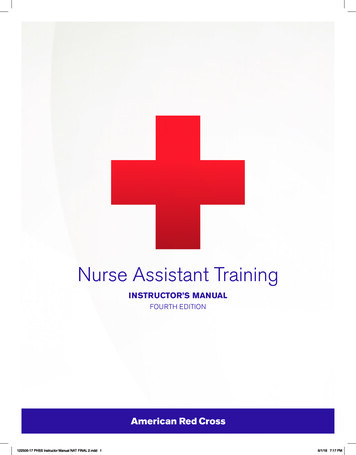
Transcription
Nurse Assistant TrainingINSTRUCTOR’S MANUALFOURTH EDITION122506-17 PHSS Instructor Manual NAT FINAL 2.indd 16/1/18 7:17 PM
Nurse Assistant TrainingThis fourth edition of the American Red Cross Nurse Assistant Training Instructor’s Manual is acomprehensive resource that focuses on the skills and concepts a nurse assistant needs to knowin order to provide compassionate, competent and person-centered care. The manual includes: Lesson outline consistent with textbook content that helps you prepare students to learnrequired skills and concepts. Proven learning aids and activities that help students master the course content and preparethem to be effective members of the health care team. User-friendly skill sheets that provide clear instructions for core nurse assistant skills, with anemphasis on the six principles of care:Safety Infection Control Privacy Dignity Communication IndependenceBehind every American Red Cross health and safety training program stands a team of expertsensuring what is taught is based on the latest and best scientific and technical information.The American Red Cross Scientific Advisory Council is a panel of nationally recognized expertsdrawn from a wide variety of scientific, medical and academic disciplines. The Council providesauthoritative guidance on first aid, CPR, emergency treatments, rescue practices, emergencypreparedness, aquatics, disaster health, nursing, education and training.For more information on the Scientific Advisory Council, visit redcross.org/science.MissionThe American Red Cross prevents and alleviates humansuffering in the face of emergencies by mobilizing thepower of volunteers and the generosity of donors.ISBN 978-158480709-49 781584 807094Stock No. 754078 Asset No. 122506-17 6/18122506-17 PHSS Instructor Manual NAT FINAL 2.indd 26/1/18 7:17 PM
American Red CrossNurse Assistant TrainingINSTRUCTOR’S MANUAL
This instructor’s manual is part of the American Red Cross Nurse Assistant Training program. By itself, it doesnot constitute complete and comprehensive training. Visit redcross.org to learn more about this program.The emergency care procedures outlined in this book reflect the standard of knowledge and acceptedemergency practices in the United States at the time this textbook was published. It is the reader’sresponsibility to stay informed of changes in emergency care procedures.The infection control procedures outlined in this book reflect the current standards and guidelines of theCenters for Disease Control (CDC) and Occupational Safety and Health Administration (OSHA) in theUnited States at the time this textbook was published. Because regulations influencing these standards andguidelines change frequently and because laws are redefined, it is the reader’s responsibility to stay currentwith information such as infection control by attending in-service courses offered by employers or throughother sources.The materials in this book, including all content, graphics, images, logos, and downloadable electronicmaterials (as applicable) are copyrighted by and the exclusive property of The American National Red Cross(“Red Cross”) or licensed by Red Cross from their respective owners. Unless otherwise indicated in writing bythe Red Cross, the Red Cross grants you (“Recipient”) the limited right to receive and use the materials only inconjunction with teaching, preparing to teach, or participating in a Red Cross course by individuals or entitiesexpressly authorized by the Red Cross, subject to the following restrictions:xx The Recipient is prohibited from creating new versions of the materials, electronic or otherwise.Recipient is prohibited from revising, altering, adapting or modifying the materials, which includesxx Theremoving, altering or covering any copyright notices, Red Cross marks, logos or other proprietary noticesplaced or embedded in the materials.Recipient is prohibited from creating any derivative works incorporating, in part or in whole, thexx Thecontent of the materials.Recipient is prohibited from downloading the materials, or any part of the materials, and putting themxx Theon the Recipient’s own website or other third-party website without advance written permission of theRed Cross.The Recipient is prohibited from removing these Terms and Conditions in otherwise-permitted copies, andis likewise prohibited from making any additional representations or warranties relating to the materials.Any rights not expressly granted herein are reserved by the Red Cross. The Red Cross does not permit itsmaterials to be reproduced or published without advance written permission from the Red Cross. To requestpermission to reproduce or publish Red Cross materials, please submit an initial written request to TheAmerican National Red Cross by going to the Contact Us page on redcross.org and filling out the GeneralInquiry Form. Our Public Inquiry unit will reply with our copyright permission request form. 2002, 2009, 2013, 2018 by The American National Red Cross. ALL RIGHTS RESERVED.The Red Cross emblem, American Red Cross and the American Red Cross logo are trademarks of TheAmerican National Red Cross and protected by various national statutes.Published by The StayWell Company, LLCPrinted in the United States of AmericaISBN: 978-1-58480-709-4How far you go in life depends on your being tender with the young, compassionate with the aged,sympathetic with the striving, and tolerant of the weak and strong—because someday in life you will havebeen all of these. —George Washington Carver
AcknowledgmentsMany individuals shared in the development and revision process in various supportive, technical andcreative ways. The American Red Cross Nurse Assistant Training Instructor’s Manual was developedthrough the dedication of both employees and volunteers. Their commitment to excellence made thismanual possible.DedicationThis manual is dedicated to the employees and volunteers of the American Red Cross who contributetheir time and talent to supporting and teaching caregiving skills worldwide, and to the students who havedecided to make a career out of helping others.American Red Cross Scientific Advisory CouncilAmerican Red Cross Scientific Advisory Council Guidance and Review of the Nurse Assistant Trainingprogram was provided by members of the American Red Cross Scientific Advisory Council. The AmericanRed Cross Scientific Advisory Council is a panel of nationally recognized experts drawn from a wide varietyof scientific, medical and academic disciplines. The Council provides authoritative guidance on first aid,CPR, emergency treatments, rescue practices, emergency preparedness, aquatics, disaster health, nursing,education and training. For more information on the Scientific Advisory Council, visit ��council. Acknowledgments iii
ContentssectionAConducting the Course . . . . . . . . . . . . . . . . . . . . 1Course Administration . . . . . . . . . . . . . . . . . . . . . . . . 3Purpose of the Course . . . . . . . . . . . . . . . . . . . . . . 3Instructor Responsibilities . . . . . . . . . . . . . . . . . . . . 3Course Design . . . . . . . . . . . . . . . . . . . . . . . . . . . 4Student and Instructor Resources . . . . . . . . . . . . . . . 5Setting Up and Running This Course . . . . . . . . . . . . . 7Requirements for Successful Course Completion . . . . . . 9Setting Up and Running Skill Practice Sessions . . . . . . 11Setting Up and Running the Clinical Practicum . . . . . . . 12Administrative Tasks at the Conclusion of the Course . . . 15sectionBLessons . . . . . . . . . . . . . . . . . . . . . . . . . . . . . . . . . 17Introduction to the Course . . . . . . . . . . . . . . . . . . . . . 19iv LESSON1:Being a Nurse Assistant . . . . . . . . . . . . . . 27LESSON2:Protecting the People in Your Care . . . . . . . 45LESSON3: Acting in an Ethical andProfessional Manner . . . . . . . . . . . . . . . . 63LESSON4:Understanding the People in Your Care . . . . . 71LESSON5:Communicating with People . . . . . . . . . . . . 83LESSON6: Understanding the Bodyand How It Functions . . . . . . . . . . . . . . . . 97LESSON7:Controlling the Spread of Infection . . . . . . . 109LESSON8:Preventing Injuries . . . . . . . . . . . . . . . . 129LESSON9:Responding to Emergencies . . . . . . . . . . . 145 Nurse Assistant Training Instructor’s Manual
SECTION B (continued)LESSON 10: Measuring Vital Signs and Other Data . . . . . 161LESSON11: Assisting with Positioningand Transferring . . . . . . . . . . . . . . . . . . 191LESSON12: Providing Restorative Care . . . . . . . . . . . . 225LESSON13: Maintaining a Comfortable Environment . . . . 239LESSON14: Assisting with PersonalCleanliness and Grooming . . . . . . . . . . . . 259LESSON15: Assisting with Meals and Fluids . . . . . . . . . 309LESSON16: Assisting with Elimination . . . . . . . . . . . . 323LESSON17: Promoting Comfort and Rest . . . . . . . . . . 367LESSON18: Assisting with Admissions,Transfers and Discharges . . . . . . . . . . . . 383LESSON19: Providing Care for Peoplewith Specific Illnesses . . . . . . . . . . . . . . 393LESSON20: Providing Care for People withDementia and Other Cognitive Changes . . . . 415LESSON21: Providing Care for Peopleat the End of Life . . . . . . . . . . . . . . . . . 431LESSON22: Providing Care to Infants and Children . . . . . 445LESSON23: Providing Care for People in Their Homes . . . 463LESSON24: Entering the Workforce . . . . . . . . . . . . . . 477LESSON25: Enjoying Professional Success . . . . . . . . . 493Final Examination . . . . . . . . . . . . . . . . . . . . . . . . . 508Review Day . . . . . . . . . . . . . . . . . . . . . . . . . . . . . 511Contents v
sectionCFinal Exams, Answer Sheets,Index, Answer Keys . . . . . . . . . . . . . . . . . . . . . . 515Student Competency Evaluation—Oral (Version A) . . . . . 517Student Competency Evaluation—Oral (Version B) . . . . . 524Answer Sheet: Student Competency Evaluation—Oral . . . 531Student Competency Evaluation—Written (Version A) . . . 533Student Competency Evaluation—Written (Version B) . . . 542Answer Sheet: S tudent CompetencyEvaluation—Written . . . . . . . . . . . . . . 551Index . . . . . . . . . . . . . . . . . . . . . . . . . . . . . . . . 553Answer KeysAnswer Key: S tudent Competency Evaluation—Oral(Version A) . . . . . . . . . . . . . . . . . . . 567Answer Key: S tudent Competency Evaluation—Oral(Version B) . . . . . . . . . . . . . . . . . . . 571Answer Key: S tudent Competency Evaluation—Written(Version A) . . . . . . . . . . . . . . . . . . . 575Answer Key: S tudent Competency Evaluation—Written(Version B) . . . . . . . . . . . . . . . . . . . 579vi Nurse Assistant Training Instructor’s Manual
LE S S O N7Controlling the Spreadof InfectionSuggested Lesson Length: 6 hoursLESSON OBJECTIVESAfter completing the session, students should be able to:Describe how infections can be spread from onexxApply standard precautions and transmission-basedxxRecognize the signs and symptoms of an infection.xxTake measures to control the spread of microbes thatxxUnderstand their role and their employer’s rolexxperson to another.can cause infection.precautions.in protecting them from exposure to bloodbornepathogens on the job.After completing the skill sessions, students will be able to:Wash hands in a way that controls the spread ofxxmicrobes that can cause infection.Open and close a trash bag correctly and double-bagxxcontaminated trash and laundry.Put on and take off personal protective equipmentxx(PPE) correctly.GUIDANCE FOR THE INSTRUCTORTo complete this lesson and meet the lesson objectives, you must:Identify the causes of infection.xxShow the video segment, “Introduction to InfectionxxControl.”Describe the chain of infection.xxExplain the term healthcare-associated infection andxxits significance.List the common signs and symptoms of an infection.xxRemind students that infection control is one of thexxsix principles of care.Describe measures to control the spread of microbes,xxemphasizing the importance of hand washing.Show the video segment, “Hand Washing.”xxConduct the Skill Session: Hand Washing.xxDescribe different types of personal protectivexxequipment.Show the video segment, “Using Personal ProtectivexxEquipment.”Conduct the Skill Session: Using Personal ProtectivexxEquipment (PPE).Discuss standard precautions and when they arexxused; discuss transmission-based precautions,including examples of when they are used.Conduct the Skill Session: Handling a PlasticxxTrash Bag.Describe the term bloodborne pathogens andxxexplain the standards required for employers.LESSON7 Controlling the Spread of Infection 109
MATERIALS, EQUIPMENT AND SUPPLIESNurse Assistant Training textbookxxNurse Assistant Training DVD setxxLCD projector, screen and computerxxPresentation for Lesson 7, Controlling the Spreadxxof InfectionSoap, running waterxxPaper towelsxxOrange stick or nail brush (optional)xxLotion (optional)xxPersonal protective equipment: gowns, gloves,xxmasks, protective eyewearSharps containerxxBlank easel pad pagesxxMarkersxxState required documentationxxSkill Check-Off Sheets: Skill 7-1, Hand Washing;xxSkill 7-2, Using Personal Protective Equipment (PPE);Skill 7-3, Handling a Plastic Trash BagStudent Handout: Student Handout 7-1, Chain ofxxInfectionStudent Handouts (to be printed from Instructor’sxxCorner){{xxBiohazard warning labelsxxPlastic trash bags{{CDC Clean Hands Count fact sheetOSHA’s Bloodborne Pathogens Standard factsheetTOPIC: INTRODUCTIONINSTRUCTIONTime: 5 minutesMicrobes are tiny living things that can only be seen with a microscope; they includexxbacteria, viruses, fungi, yeasts and molds.REFERENCESPresentation, Unit 2Most microbes grow in areas that are warm, moist and dark and where food is available.xxSome microbes are not harmful while others are.xx{{Pathogens are harmful microbes that cause disease; the disease is called an infection.TOPIC: THE CHAIN OF INFECTIONINSTRUCTIONTime: 20 minutesEngage students in a discussion about infections.xx{{{{Ask them if any of them have had an infection.If so, have them describe what the infection was like, including if they knew what wasthe cause of the infection, such as a virus or bacteria.{{Have them identify how they think they got the infection.{{Ask them to suggest ways they could have prevented getting the infection.Instructor’s Note: Stress to the class that no one should feel obligated to sharepersonal health information with the class; sharing examples is voluntary.INSTRUCTION110 Show the video segment, “Introduction to Infection Control” (5:04). Nurse Assistant Training Instructor’s Manual
INSTRUCTIONREFERENCESPresentation, Unit 2StudentHandout 7-1Instructor’s Note: Give the students Student Handout 7-1, Chain of Infection.For infections to be passed from one person to another, six requirements must be met.xxThis is called the chain of infection. Here are the six links in the chain:xx{{Pathogen: Presence of a microbe capable of causing disease{{Reservoir»»Place where microbes grow and multiply»»Examples: bodies of people and animals, bodies of water, food{{Portal of exit»»Way of leaving the reservoir»»Dependent on pathogen and reservoir»»Examples: respiratory tract, digestive tract, genitourinary tract or breaks in the skin{{Method of transmission»»Way a pathogen gets from one person to another»»Direct through close physical contact»»Indirect through contaminated surfaces or objects{{Portal of entry»»Way of gaining entrance to a new reservoir»»Examples: respiratory tract, digestive tract, genitourinary tract, eyes or breaks inthe skin{{Susceptible host»»Person who is capable of becoming infected with the particular pathogen»»Increased susceptibility in very young or aged population, poor general health andthe presence of medical devices implanted in the bodyEliminating just one link in the chain can prevent an infection from spreading.xxTOPIC: HEALTHCARE-ASSOCIATEDINFECTIONSINSTRUCTIONTime: 5 minutesHealthcare-associated infections are infections that a person acquires while in a healthcarexxfacility.REFERENCESPresentation, Unit 2These infections are often referred to as nosocomial infections.xxHealthcare-associated infections lead to longer lengths of stay, delayed recovery,xxincreased costs and increased risk for serious complications, and even death.People receiving care in healthcare facilities are more susceptible to developing infectionsxxand, if infection occurs, it is harder for their bodies to overcome the infection.Also, some of the microbes are difficult to treat.xxOver time, microbes become resistant to antibiotics used for treatment so that thexxmedication is no longer effective.This leads to the development of hard-to-treat “super-bugs.”xxLESSON7 Controlling the Spread of Infection 111
“SUPER-BUGS”INSTRUCTION“Super-bugs” are difficult to treat.xxBasic infection control measures are extremely effective for preventing the spread of thesexxvery dangerous microbes as well as other microbes that cause tion, Unit 2The key is to use infection control measures properly and consistently.xxExamples of hard-to-treat “super-bugs” include the following:xx{{Methicillin-resistant Staphylococcus aureus (MRSA)»»Staph infection spread by direct contact possibly causing serious skin infections»»Possible development of serious infections of the blood, lungs, heart or bone ifbacterium enters the body, such as through a cut in the skin{{Clostridium difficile, or C-diff»»Microbe that is passed from the body in feces; contact with contaminated surfacesor hands spreads infection to others»»Bacterial invasion of the bowel causing diarrhea and pain»»Spores produced from microbe that can live on hands and surfaces for a long time»»Hand washing with soap and water essential; alcohol-based hand rubs not effectivefor removing C. difficile»»Disinfectant containing bleach necessary to clean hard surfaces{{Vancomycin-resistant Enterococcus (VRE)»»Infections of wounds, intestinal tract and urinary tractTOPIC: SIGNS AND SYMPTOMS OF INFECTIONINSTRUCTIONTime: 5 minutesCertain signs and symptoms occur with an infection but these vary based on the pathogenxxand the location of the infection.Common signs and symptoms include:xxREFERENCESPresentation, Unit 2{{High body temperature.{{Headache.{{Flushed face.{{Red or draining eyes.{{Loss of appetite.{{Nausea, vomiting, diarrhea.{{Stomach pain.{{Stuffy nose.{{Coughing.{{Sore throat.{{Skin rash.{{Sores.{{Cloudy or smelly urine.{{Joint pain.{{Muscle ache.{{Redness around and/or drainage from a wound or incision.{{Swelling.(Continued)112 Nurse Assistant Training Instructor’s Manual
Older adults may not have a fever even if infection is present because they may havexxother chronic conditions, use medication or have changes in their immune system that caninterfere with producing a fever. Be alert for other possible signals in older adults such as:{{ New onset of confusion or increased confusion.{{ Changes in eating or appetite.{{ New onset of loss of bladder or bowel control or more frequent episodes ofincontinence.{{ Fatigue or lethargy.{{ Flu-like symptoms.You need to report your observations to the nurse if you notice that someone in your carehas one or more of the signs and symptoms.Early recognition of infections helps you ensure that the person receives prompt treatment.Early recognition also helps prevent the spread of infection to others.You need to practice infection control with every person in your care, even if you do notobserve any signs or symptoms.xxxxxxxxTOPIC: INFECTION CONTROLINSTRUCTIONTime: 15 minutesInfection control refers to those actions that you take to control the spread of microbes thatxxcause disease.Remember, infection control is one of the six principles of care.xxREFERENCESPresentation, Unit 2INSTRUCTIONBreak the class into several small groups. Ask each group to create a list of actions thatxxthey already do to prevent infection in their everyday lives.Then bring the groups together and have them report their information. Write theirresponses on a blank easel pad page.Then compare their responses to the general actions described below.xxINSTRUCTIONxxYou already use general actions to help control the spread of microbes.xxSome general actions to take include the following:xx{{REFERENCES{{Presentation, Unit 2{{Textbook, Chapter 7{{{{{{{{{{{{{{{{{{Cleansing your hands frequently, using soap and water or an alcohol-based hand rubTaking care of your body by eating well, exercising and getting enough rest to keep yourimmune system healthyGetting vaccinated and keeping vaccinations up to dateStaying home if you are sickRecognizing and reporting signs and symptoms of infectionMaintaining cleanlinessEnsuring single use of personal equipment, such as bedpans, urinals, washbasins,emesis basins, toothbrushes, toothpaste, lotion and soapHandling linens properly, making sure to keep dirty linens away from your uniform, notshaking dirty linens, placing dirty linens in the laundry bag in the person’s room beforecarrying the bag to the laundry hamper outside the room, and placing wet and soiledlinens in a plastic or leakproof laundry bagCovering bedpans and urinals when carrying them from one place to anotherPreparing food carefullyServing meals immediately as soon as they arrive or when preparedStoring foods carefully(Continued)LESSON7 Controlling the Spread of Infection 113
Four common methods of infection control used in healthcare settings include handxxhygiene (washing with soap and water or using an alcohol-based hand sanitizer),decontaminating objects and surfaces, using personal protective equipment and takingisolation precautions.Instructor’s Note: Have students open their textbooks and refer to Box 7-2,General Actions That Help to Control the Spread of Microbes.TOPIC: HAND HYGIENEINSTRUCTIONREFERENCESPresentation, Unit 2Textbook, Chapter 7CDC Clean HandsCount Fact SheetTime: 1 hourHand hygiene is one of the most important things you can do to stop the spread of microbes.xxAs a nurse assistant, you clean your hands in a special way to ensure that all surfacesxxare clean.You need to wash your hands with soap and water whenever they are visibly soiled withdirt, blood or body fluids.xxBody fluids include urine, feces, saliva, mucus, vomit, semen, vaginal secretions, breastmilk and wound drainage.You should also wash your hands with soap and water before eating or handling food, afterusing the bathroom and if you have had contact with organisms that cause certain types ofdiarrhea.In most other circumstances, you may use an alcohol-based hand sanitizer to clean yourhands instead of washing with soap and water.{{ The sanitizer should contain at least 60 percent alcohol.{{ Use the amount of product recommended by the manufacturer.{{ Rub it thoroughly over all surfaces of the hands including the nails and between fingersfor at least until the product dries (at least 20 seconds).{{ Always follow your employer’s policy for using an alcohol-based hand sanitizer.You should clean your hands:{{ As you are coming on duty.{{ Before and after contact with a person in your care.{{ Before and after putting on gloves.{{ After using the bathroom.{{ After coughing, sneezing or blowing your nose.{{ After smoking.{{ After handling dirty supplies or equipment.{{ Before eating or handling food.{{ Before handling clean supplies or equipment.{{ Before going home.{{ After any possible contact with infectious organisms that might cause diarrhea.{{ Any time they become visibly soiled with dirt or body fluids.{{ Any other time you think it may be important.{{xxxxxxInstructor’s Note: Give the students Clean Hands Count, the current CDCprovider fact sheet on clean hands. To access and print the handout current atthe time of publication, visit Instructor’s Corner.Instructor’s Note: Have students open their textbooks and refer to Box 7-4,Nurse Assistant DOs and DON’Ts: Hand Washing.114 Nurse Assistant Training Instructor’s Manual
INSTRUCTIONShow the video segment, “Hand Washing” (5:12).INSTRUCTIONTell students that they will practice hand washing. Have students turn to Skill 7-1 in thexxtextbook.Hand WashingREFERENCESTextbook, Chapter 7Review the preparation steps for this skill.xxDemonstrate the procedure for hand washing, following the steps of the skill exactly asxxpresented.{{Explain why each step is necessary.{{Ask for and answer students’ questions.Have students break into pairs or small groups and practice the skill.xxObserve the practice, guiding students through the skill. Give help when appropriate orxxwhen requested.Have students inform you when they are ready to be evaluated for mastery of the skill.xxObserve the student’s performance against Skill Check-Off Sheet 7-1, Hand Washing.xxWhen finished demonstrating the skill, offer positive feedback about what the student didxxcorrectly and make constructive, specific suggestions about changes that are needed.Sign or initial the state required documentation.xxProvide a brief review of the skill practice, emphasizing the effectiveness of correct handxxwashing techniques and correcting any misconceptions students may have about thehand washing skill.TOPIC: CLEAN OBJECTS AND SURFACESINSTRUCTIONREFERENCESPresentation, Unit 2Time: 10 minutesInstructor’s Note: Ask students to define or describe what is meant by the termsclean and dirty.Clean items or surfaces are free of pathogens and dirt.xxDirty items or surfaces are considered contaminated because they contain dirt or pathogens.xxAn unused item is considered to be clean until it comes into contact with the person orxxtheir environment. Then it is considered dirty and cannot be reused for another person.In facilities, clean, unused supplies are stored in the clean utility room; used supplies thatxxmust be cleaned or laundered are returned to the dirty utility room; the dirty utility room alsohas trash containers for discarding of used disposable supplies.METHODS FOR CLEANINGINSTRUCTIONOne of your responsibilities is to help keep the person’s environment clean. You mayxxalso be responsible for cleaning some types of equipment after you use it.Simply washing the object or surface with soap and water will remove dirt and somexxmicrobes.REFERENCESPresentation, Unit 2You can use a disinfectant to kill microbes on the object or surface.xx{{The facility will specify which disinfectant to use.{{You can make a disinfectant solution by mixing 1½ cups of bleach into 1 gallon of water.{{Let the disinfectant or bleach solution stand on the surface for the recommendedamount of time (usually 1 to 3 minutes for a disinfectant solution; 10 to 15 minutesfor a bleach solution).(Continued)LESSON7 Controlling the Spread of Infection 115
Sterilization is used to kill all microbes on an object or surface.xxObjects being placed inside a person’s body, such as an indwelling urinary catheter, mustxxbe sterile.Sterilization is achieved using gas, chemicals, dry heat or pressurized steam.xx{{{{In facilities, a special department (often called Central Supply) is usually responsible forsterilizing objects.At home, boiling an object for 20 minutes is an effective means of sterilization.TOPIC: PERSONAL PROTECTIVE EQUIPMENTINSTRUCTIONTime: 2 hoursPersonal protective equipment or PPE is protective gear that is worn to prevent microbesxxfrom contaminating the uniform, skin or mucous membranes.Properly using PPE eliminates a portal of entry for potential pathogens and helps keep youxxsafe from infection.REFERENCESPresentation, Unit 2PPE includes gloves, gowns, masks and eyewear.xxPPE is usually put on outside of the person’s room and removed and discarded insidexxthe room.When multiple PPE items need to be worn, they are put on in this order:xx{{Gown{{Mask{{Protective eyewear{{GlovesWhen you remove PPE, you do so in this order:xx{{Gloves{{Protective eyewear{{Gown{{MaskxxRemoving PPE in the proper order helps protect you from contaminating yourself oryour uniform.GLOVESINSTRUCTIONDisposable gloves, usually made of vinyl, nitrite or latex, are meant to be worn once andxxthen discarded.REFERENCESPresentation, Unit 2They should fit properly and be free of tears or rips.xxGloves are worn whenever there is a possibility of coming into contact with a person’sxxblood or body fluids, such as when:{{The person in your care has broken skin.{{You need to provide care that involves touching the person’s mucous membranes.{{You must handle items or surfaces soiled with blood or body fluids.You also wear gloves when there is a break in the skin of your hands.xxYou may need to change gloves several times during one procedure to avoid contaminatingxxclean surfaces by touching them with dirty gloves.You must always wash your hands after removing gloves and before putting on a new pair.xxWhen you are finished caring for one person, you always remove and discard your glovesxxand wash your hands before leaving the room or assisting another person.Most facilities do not use latex gloves, since some people are allergic to latex.xx(Continued)116 Nurse Assistant Training Instructor’s Manual
If you or the person you are caring for develops
The American Red Cross prevents and alleviates human suffering in the face of emergencies by mobilizing the power of volunteers and the generosity of donors. Nurse Assistant Training This fourth edition of the American Red Cross
